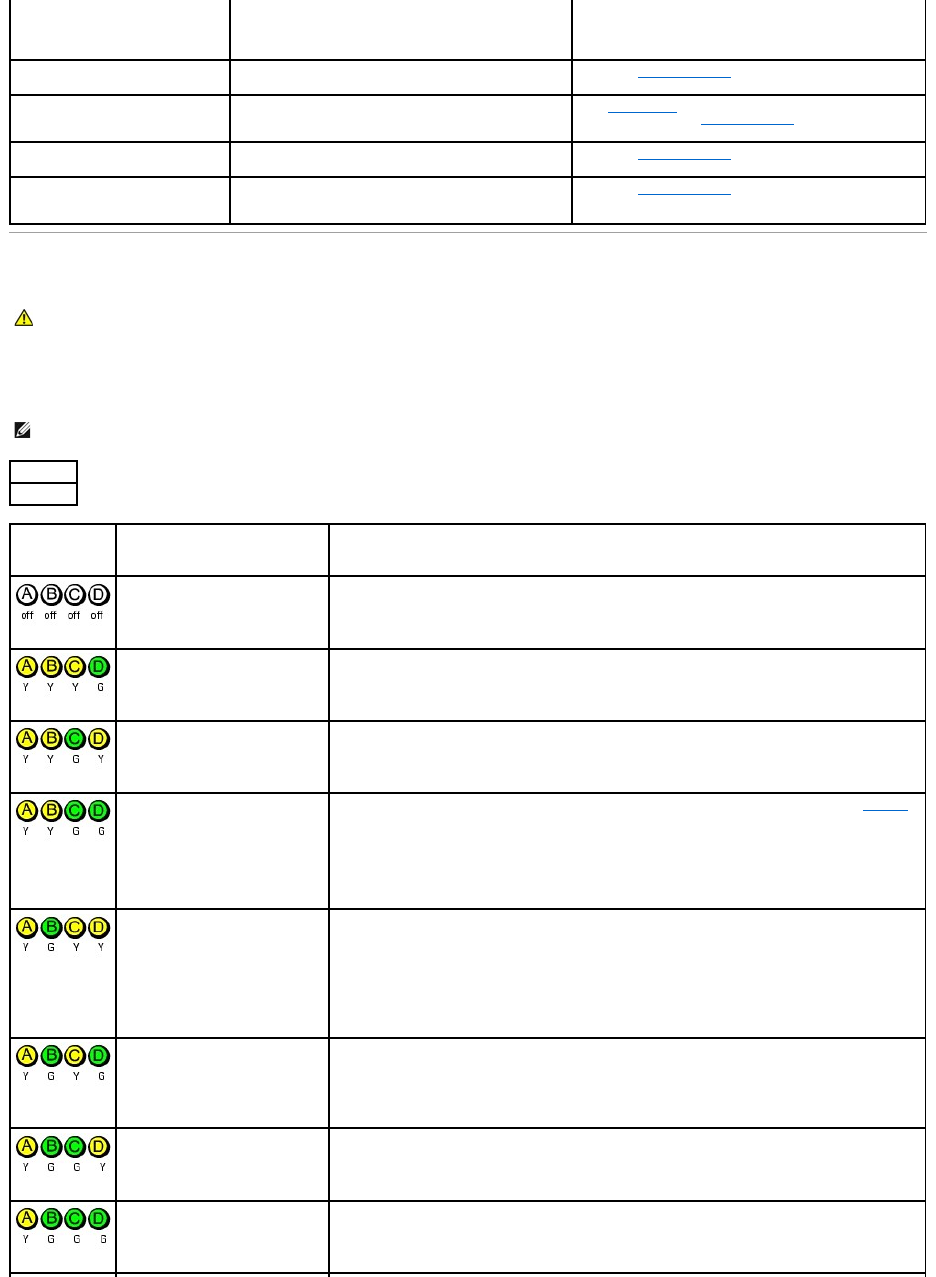
Diagnostic Lights
To help you troubleshoot a problem, your small form factor, small desktop, and small mini-tower computers have four lights labeled "A," "B," "C," and "D" on
the back panel. The lights can be yellow or green. When the computer starts normally, the patterns or codes on the lights change as the boot process
completes. If the POST portion of system boot completes successfully, all four lights display solid green. If the computer malfunctions during the POST process,
the pattern displayed on the lights may help identify where in the process the computer halted.
identified.
If the computer does not boot, contact Dell for technical
assistance.
A power supply or system board failure has occurred.
Check the diagnostic lights to see if the specific problem is
identified. Also, see "Power Problems."
Solid green and a beep code during
POST
A problem was detected while the BIOS was executing.
See "Beep Codes" for instructions on diagnosing the beep
code. Also, check the diagnostic lights to see if the specific
problem is identified.
Solid green power light and no beep
code and no video during POST
The monitor or the graphics card may be faulty or
incorrectly installed.
Check the diagnostic lights to see if the specific problem is
identified. See "Video and Monitor Problems."
Solid green power light and no beep
code but the computer locks up
during POST
An integrated system board device may be faulty.
Check the diagnostic lights to see if the specific problem is
identified. If the problem is not identified, contact Dell for
technical assistance.
CAUTION: Before you begin any of the procedures in this section, follow the safety instructions located in the Product Information Guide.
NOTE: The orientation of the diagnostic lights may vary depending on the system type. The diagnostic lights can appear either vertical or horizontal.
The computer is in a normal off
condition or a possible pre-BIOS
failure has occurred.
Plug the computer into a working electrical outlet and press the power button.
A possible BIOS failure has
occurred; the computer is in the
recovery mode.
Run the BIOS Recovery utility, wait for recovery completion, and then restart the computer.
A possible processor failure has
occurred.
Reinstall the processor and restart the computer.
Memory modules are detected, but
a memory failure has occurred.
l If you have one memory module installed, reinstall it and restart the computer. See "Memory"
for instructions on how to remove and install memory modules.
l If you have two or more memory modules installed, remove the modules, reinstall one module,
and then restart the computer. If the computer starts normally, reinstall an additional module.
Continue until you have identified a faulty module or reinstalled all modules without error.
l If available, install properly working memory modules of the same type into your computer.
l If the problem persists, contact Dell.
A possible expansion card failure
has occurred.
l Determine if a conflict exists by removing a card (not the graphics card) and then restarting
the computer.
l If the problem persists, reinstall the card that you removed, remove a different card, and then
restart the computer.
l Repeat this process for each card. If the computer starts normally, troubleshoot the last card
removed from the computer for resource conflicts.
l Move each card one at a time to a different PCI slot and restart the computer after each move.
l If the problem persists, contact Dell.
A possible graphics card failure has
occurred.
l If the computer has a graphics card, remove the card, reinstall it, and then restart the
computer.
l If the problem still exists, install a graphics card that you know works and restart the
computer.
l If the problem persists or the computer has integrated graphics, contact Dell.
A possible floppy or hard drive
failure has occurred.
Reseat all power and data cables and restart the computer.
A possible USB failure has
occurred.
Reinstall all USB devices, check cable connections, and then restart the computer.
